Best Practices for Optimizing Your Email Campaigns
Are you truly maximizing the potential of your email marketing efforts?
Every day, over 361 billion emails are sent and received—a number projected to rise to 408 billion by 2027, according to Statista.
With such vast reach, email marketing is a powerful tool for digital marketers. It enables you to nurture leads, engage customers, and strengthen brand awareness within your target audience.
Even if your current email campaigns are delivering results, there are strategies to enhance their performance and make this channel work even harder for you.

1) Email structure and content
Email marketing comes with endless possibilities—from design and formatting to content structure—making it essential for marketers to make the right choices.
Let’s explore some simple yet effective ways to craft a high-performing marketing email.
Subject line
The subject line of an email is the first thing recipients see in their inbox—and it can determine whether they open it or ignore it.
In fact, according to Optinmonster, 47% of people open emails based on the subject line alone!
So, how can you craft subject lines that grab attention and drive clicks?
-
Keep it short: Aim for 5–7 words (40–60 characters).
-
Make it personal: Use the recipient’s name or relevant details.
-
Create urgency: Phrases like “Limited Time Offer” or “Last Chance” encourage quick action.
-
Be clear: Communicate the value upfront—no misleading clickbait.
For example, the cat food brand Untamed uses the subject line: “Personalize your cat’s menu.”
This works because it speaks directly to the recipient (“your”), appeals to their love for their pet, and promises something tailored just for them.
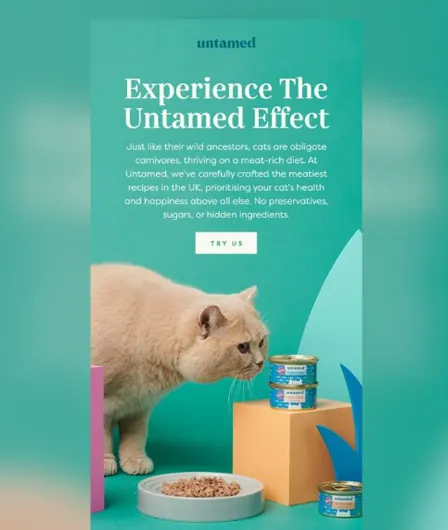
On the other hand, a weak subject line like “Check Out Our New Products!” falls flat because it’s too generic, lacks personalization, and doesn’t clearly convey any value to the recipient.
Word count
When writing an email, it’s essential to focus on what’s necessary and cut out any excess text.
Since most people skim emails rather than reading every word, your message should be clear and concise so they can quickly grasp the main point.
The ideal length of an email depends on its purpose. For example, promotional emails should be brief, while newsletters can be slightly longer.
Here’s a general guide for email length:
-
Newsletters: 200–300 words—enough to provide value without overwhelming readers.
-
Promotional emails: 50–125 words—short and to the point, driving quick action.
-
Content-based emails: 150–300 words—depending on the depth of the content.
For instance, the U.S. restaurant chain Sweetgreen uses a concise promotional email to showcase its fall menu. The email features eye-catching colors, minimal text, and bold CTA buttons to capture attention and encourage engagement.
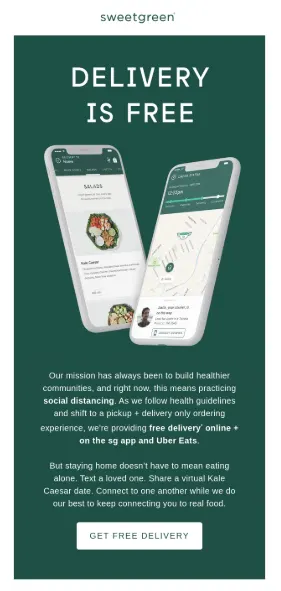
Content and layout
With overflowing inboxes and readers who skim rather than read, it’s essential to carefully consider both the content and layout of your emails.
Key design elements—such as color, white space, CTA buttons, and imagery—can significantly impact engagement.
Here are some simple but effective guidelines to improve readability and structure:
-
Use an inverted pyramid or iceberg layout: Start with the most important information at the top.
-
Balance text and images: Aim for a 60% text to 40% image ratio.
-
Leverage white space: This enhances readability and prevents the email from feeling cluttered.
-
Optimize font sizes: Use 14–16px for body text and 18–22px for headers.
A great example is Grammarly’s email, which follows the inverted pyramid structure—leading with a strong headline, followed by key content, and ending with a bold CTA button for clear direction.
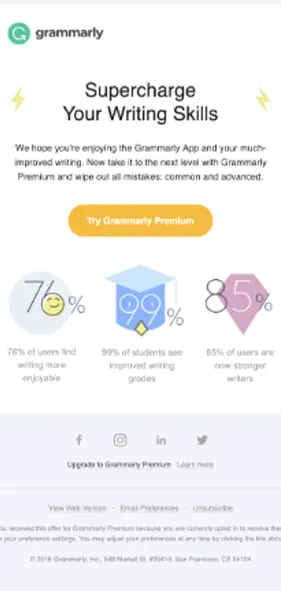
CTAs
Call-to-actions (CTAs) are a powerful way to boost engagement and increase email click-through rates.
Since space is limited in emails, it’s crucial to be strategic about the number of CTAs you include. A study by Omnisend analyzing 229 million emails sent over a Black Friday to Cyber Monday weekend found that emails with three or more CTAs had lower click-through rates than those with fewer.
Here are key best practices for crafting effective CTAs:
-
Be direct: Use action-driven verbs like “Download,” “Get,” or “Claim.”
-
Create contrast: Make your CTA button a bold, eye-catching color that stands out.
-
Optimize placement: Position CTAs above the fold (so readers don’t have to scroll) and consider repeating one at the end if necessary.
A great example comes from Headspace, which uses color, white space, and an engaging CTA to naturally draw attention and encourage clicks.
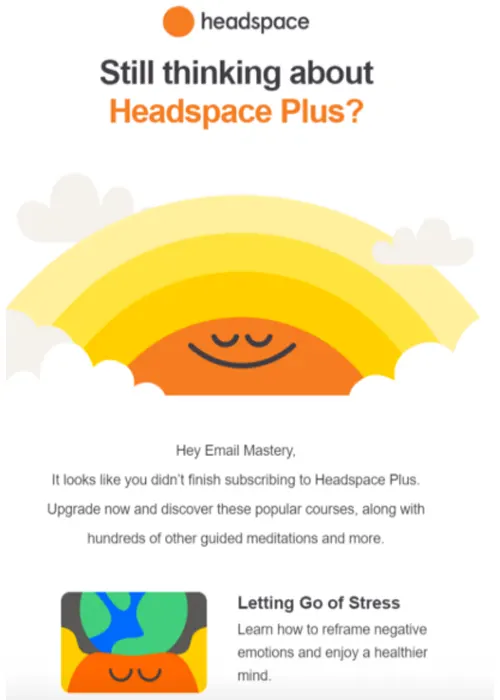
2) Developing Test Plans
What should you test in email campaigns?
There are several elements you can test in email campaigns to gain valuable insights and improve performance. These include:
-
Subject line: Try different approaches, such as a direct offer versus a more emotive style, to see which resonates better.
-
CTA: Experiment with text, placement, or even a button versus a hyperlinked CTA to measure the impact.
-
Email content: Test variations in the first paragraph or adjust the tone to see what drives more engagement.
-
Send times: Try sending emails at different times of the day and consider time zones to optimize open rates.
-
Visual content: Compare an email with a bold image or video at the top versus one without to assess effectiveness.
-
Style and layout: Test different layouts, color schemes, or font choices to see what works best for your audience.
How to create A/B test plans
Creating an effective A/B test plan for emails requires a structured approach to generate meaningful insights. Follow these eight steps:
-
Define Objectives – Determine what you want to achieve (e.g., higher open rates, more conversions).
-
Identify Test Variables – Choose what to test, such as subject lines, CTAs, or email design.
-
Segment Your Audience – Divide your audience into equal groups to ensure accurate comparisons.
-
Set Up the Test – Create two variations of your email, changing only one element at a time.
-
Run the Test – Send both versions to your segmented audience.
-
Track and Measure Results – Monitor key metrics like open rates, click-throughs, and conversions.
-
Analyze Findings – Compare the performance of each version to determine the winner.
-
Apply Insights – Use the results to refine future email campaigns for better engagement.
3) Optimizing for Mobile
According to the World Economic Forum, there are more mobile subscriptions than people on the planet. With so many users checking emails on their smartphones, it’s crucial for businesses to optimize email campaigns for mobile.
Many experts advocate for a mobile-first approach—if an email looks great on a mobile screen, it will likely work well on a desktop too.
How to Effectively Optimize Emails for Mobile:
-
Use a responsive layout: A single-column design and scalable images ensure a seamless mobile experience.
-
Keep content focused: Short subject lines, clear key information upfront, concise sentences, and bullet points improve readability.
-
Optimize font size: Use at least 16px for body text and 20px for headers to ensure easy reading on all devices.
-
Consider dark mode: Test your emails in dark mode and use transparent backgrounds and adaptable color schemes.
-
Make buttons touch-friendly: Ensure CTA buttons are large enough for easy tapping on a mobile screen.
A great example comes from King Arthur Baking Company, which showcases the difference between a well-optimized mobile email and its desktop counterpart.
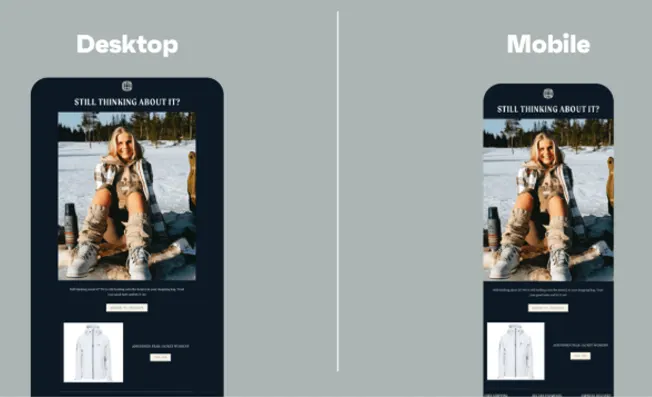
4) Email Metrics and Industry Benchmarks
Like any digital channel, tracking and analyzing key metrics is essential for understanding what’s working—and what’s not—in your email marketing.
While the specific metrics you focus on will depend on your campaign goals, here are the core email marketing metrics to monitor:
1. Engagement Metrics – Measure how your audience interacts with your emails:
-
Open rate – The percentage of recipients who open your email.
-
Click-through rate (CTR) – The percentage of recipients who click a link.
-
Click-to-open rate (CTOR) – (Clicks ÷ Opens) × 100 – Measures how effective your content is at driving clicks.
2. Delivery Metrics – Assess whether your emails are reaching inboxes:
-
Delivery rate – The percentage of emails successfully delivered.
-
Bounce rate – The percentage of emails that failed to reach recipients.
3. Conversion Metrics – Track whether recipients take the desired action:
-
Conversion rate – The percentage of recipients who complete an action (e.g., purchase, sign-up).
-
Revenue per email – (Total revenue ÷ Emails sent) – Measures the financial impact of your campaign.
4. List Health Metrics – Ensure the quality of your email list:
-
Unsubscribe rate – (Unsubscribes ÷ Emails delivered) × 100 – Tracks audience drop-off.
-
List growth rate – ((New subscribers – Unsubscribes) ÷ Total subscribers) × 100 – Measures subscriber growth over time.
5. Spam & Deliverability Metrics – Monitor potential email issues:
-
Spam complaint rate – (Spam complaints ÷ Emails delivered) × 100 – Tracks how often recipients mark emails as spam.
-
Inbox placement rate – The percentage of emails that land in the inbox vs. spam/junk folders.
Top Tip: In 2024, Google and Yahoo introduced new rules for bulk email senders (5,000+ emails per day), requiring stricter spam thresholds, email authentication, and clear unsubscribe options. Make sure your emails comply to maintain deliverability!
Industry-specific benchmarks
Industry-specific benchmarks can provide valuable insights, helping you compare your email campaign performance to others in your niche.
For example, data from email marketing platform Selzy shows that the average open rate across industries is nearly 31%. Nonprofits perform above average with a 35% open rate, while marketing falls below average at 22%. Analyzing these benchmarks can help you set realistic goals and identify areas for improvement in your email strategy.
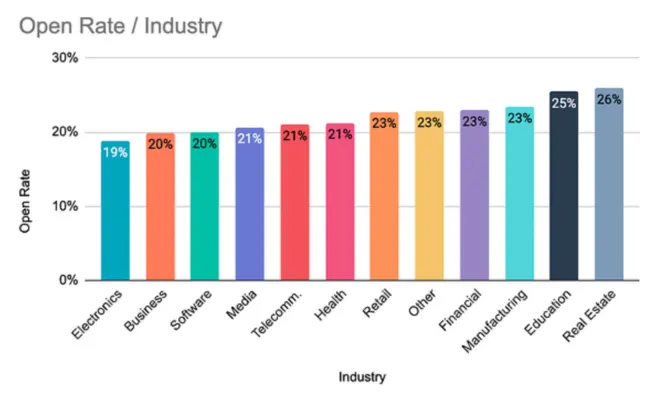
Industry-specific benchmarks can provide valuable insights, helping you compare your email campaign performance to others in your niche.
For example, data from email marketing platform Selzy shows that the average open rate across industries is nearly 31%. Nonprofits perform above average with a 35% open rate, while marketing falls below average at 22%. Analyzing these benchmarks can help you set realistic goals and identify areas for improvement in your email strategy.
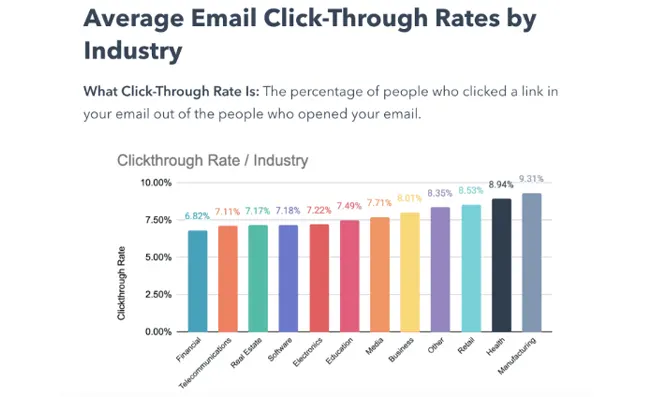
5) Full-Funnel Email Strategy
Emails play a crucial role in your marketing and sales funnel, delivering the right content to the right audience at the right time to drive engagement and increase conversions.
Email marketing is especially effective at two key stages:
-
Top of the Funnel (ToFu): Capturing interest and nurturing leads.
-
Bottom of the Funnel (BoFu): Encouraging conversions and closing sales.
Top of the Funnel (ToFu) emails
Two of the most effective Top of Funnel (ToFu) email types are newsletters and lead nurturing emails.
Newsletters
Newsletters are a powerful way to share educational content, company updates, and industry news, helping to build brand awareness and encourage engagement.
Best Practices for Newsletters:
-
Deliver value: Provide content that is educational, informative, or entertaining.
-
Maintain consistency: Stick to a regular schedule—daily, weekly, bi-weekly, or monthly—based on your resources.
-
Use visual hierarchy: Incorporate clear headings, images, and bullet points to make the email easy to scan.
A great example is The New York Times’ Morning Briefing newsletter. It immediately sets expectations by outlining the key content upfront, with an added bonus section labeled “Plus” for extra value.

Bottom of the Funnel (BoFu) Emails
Sales-driven emails
Sales-driven emails are designed to drive conversions by capturing the recipient’s attention with a compelling offer, such as a discount or a reminder about an abandoned cart.
To make these emails effective, follow these best practices:
-
Create urgency – Use time-sensitive language like “Only 24 Hours Left” to encourage immediate action.
-
Highlight benefits – Emphasize the value of your product or service rather than just listing features.
-
Provide an incentive – Offer limited-time discounts, free trials, or exclusive deals to boost conversions.
For example, Snapfish, a photo-sharing and printing service, successfully re-engages users by reminding them to complete their photo project while offering 20 free prints with a clear ‘GET YOURS’ call-to-action.
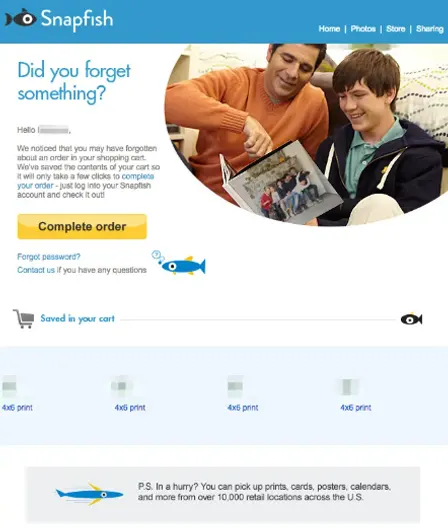
Automated trigger campaigns
Automated email campaigns triggered by user actions can be utilized at every stage of the funnel to guide prospects from sign-up to conversion.
These email workflows, also known as trigger campaigns, are powered by marketing automation and send messages automatically based on subscriber behavior. Platforms like Mailchimp, ActiveCampaign, and HubSpot make this process seamless.
Here are some best practices for automated email campaigns:
-
Behavioral Triggers – Emails sent based on user actions, such as abandoning a cart or downloading content.
-
Intent-Based Emails – Messages tailored to a subscriber’s interests or intent, like downloading a product guide or attending a webinar.
-
Welcome Series – A sequence of emails triggered when someone signs up, helping to engage new subscribers.
For example, natural soap brand Suds sends a welcome email to new subscribers, offering a special treat or discount to encourage engagement and move them through the funnel.

Pro Tip: Use webhooks for advanced trigger campaigns by sending real-time data from your website or app to your email marketing platform whenever a specific event occurs.
7) Email and AI
Artificial intelligence (AI) can automate tasks like trigger campaigns, personalize interactions, and predict user behavior patterns.
Personalize interactions
If you want to personalize your email messaging, AI-powered tools can help tailor content to individual preferences and behaviors.
This includes features like personalized product recommendations, dynamic content blocks that adjust based on user actions, and customized images and offers.
-
Adobe Campaign – Uses AI for predictive analytics and content personalization at scale.
-
Persado – Optimizes email wording and formatting based on past interactions to boost open rates and engagement.
-
Dynamic Yield – Leverages AI to adapt email content in real time based on user behavior and data.
Predictive sending
This comprehensive guide covers all aspects of email marketing, from basic setup and compliance to advanced personalization and full-funnel strategies.
For deeper insights, download “The DMI Email Marketing Playbook: The Ultimate Guide for Executing and Optimizing Campaigns.”
Use email to attract, influence and engage
A digital marketing certification is one of the fastest and most effective ways to enter the digital industry.
DMI’s Certified Professional Diploma in Digital Marketing covers the fundamentals of digital marketing, teaches you how to leverage AI in your strategy, and helps you develop essential soft skills. You’ll also explore key channels like email marketing, social media, SEO, content marketing, and display and video advertising to create successful campaigns across industries.
